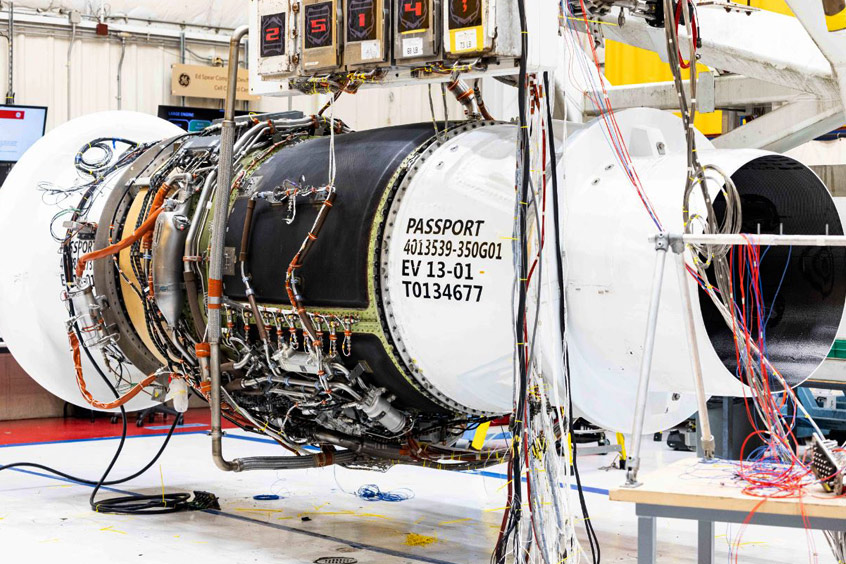Why visit ACE ’25?

GE Aerospace is developing a hybrid electric demonstrator engine with NASA that will embed electric motor/generators in a high-bypass commercial turbofan to supplement power during different phases of operation.
This includes modifying a Passport engine with hybrid electric components for testing through NASA's Hybrid Thermally Efficient Core (HyTEC) project. It's one of several efforts GE Aerospace has underway to mature technologies for more electric aircraft engines and is being advanced as part of the CFM International Revolutionary Innovation for Sustainable Engines (RISE) programme.
Embedded electric motor/generators will optimise engine performance by creating a system that can work with or without energy storage like batteries. This could help accelerate the introduction of hybrid electric technologies for commercial aviation prior to energy storage solutions being fully matured.
“Together with NASA, GE Aerospace is doing critical research and development that could help make hybrid electric commercial flight possible,” says Arjan Hegeman, general manager of future of flight technologies at GE Aerospace.
Initial component-level testing of electric motor/generators and power electronics has been completed for the HyTEC Turbofan Engine Power Extraction Demonstration. Systems testing took place at GE Aerospace's EPISCenter in Dayton, Ohio. Additionally, a baseline test of the Passport engine to characterise performance before hybrid electric components are added was completed at the company's Peebles Test Operation, also in Ohio.
Results of the hybrid electric component and baseline engine tests are being used to evaluate and update models in preparation for a ground test.
“We're advancing state-of-the-art propulsion systems for next generation commercial aircraft with an important aim, to drive industry efforts to improve efficiency and reduce emissions compared to today's aircraft engines,” Hegeman said.
NASA recently awarded GE Aerospace a contract for Phase 2 of the HyTEC project to continue developing technologies for an aircraft engine core demonstrator test later this decade. Phase 2 builds on work completed in Phase 1 of HyTEC for high-pressure compressor and high-pressure turbine advanced aerodynamics, as well as the combustor.
“Our collaborations with industry partners like GE Aerospace are paving the way for U.S. leadership in hybrid electric commercial transport aircraft,” says Anthony Nerone, HyTEC project manager, NASA's Glenn Research Center. “Single-aisle aircraft are the biggest contributors to aviation carbon emissions. That's why we're focusing on key technologies that will enable next generation single-aisle aircraft with much greater efficiency and reduced emissions than the current fleet.”
Unveiled in 2021, the RISE programme encompasses a suite of pioneering technologies, including advanced engine architectures like Open Fan, compact core, new combustor designs and hybrid electric systems to be compatible with 100 per cent sustainable aviation fuel (SAF). The CFM RISE programme targets more than 20 per cent better fuel efficiency with 20 per cent lower CO2 emissions compared to the most efficient engines in service today.
In another NASA collaboration, GE Aerospace is maturing an integrated, megawatt (MW)-class hybrid electric propulsion system as part of the Electrified Powertrain Flight Demonstration (EPFD) programme. Plans for EPFD call for ground and flight tests of the hybrid electric system this decade, in collaboration with Boeing, using a modified Saab 340B aircraft and GE Aerospace's CT7 engines.
GE Aerospace has achieved multiple milestones over the last decade for development of a hybrid electric propulsion system, including a 2016 ground test of an electric motor-driven propeller. In 2022, GE Aerospace completed the world's first test of a MW-class and multi-kilovolt (kV) hybrid electric propulsion system in altitude conditions up to 45,000 feet that simulate single-aisle commercial flight at NASA's Electric Aircraft Testbed.
GE Aerospace plans to hire more than 900 engineers in 2024, reflecting its continued focus on innovation to support current aircraft engine programmes and develop new technologies for the future of flight.